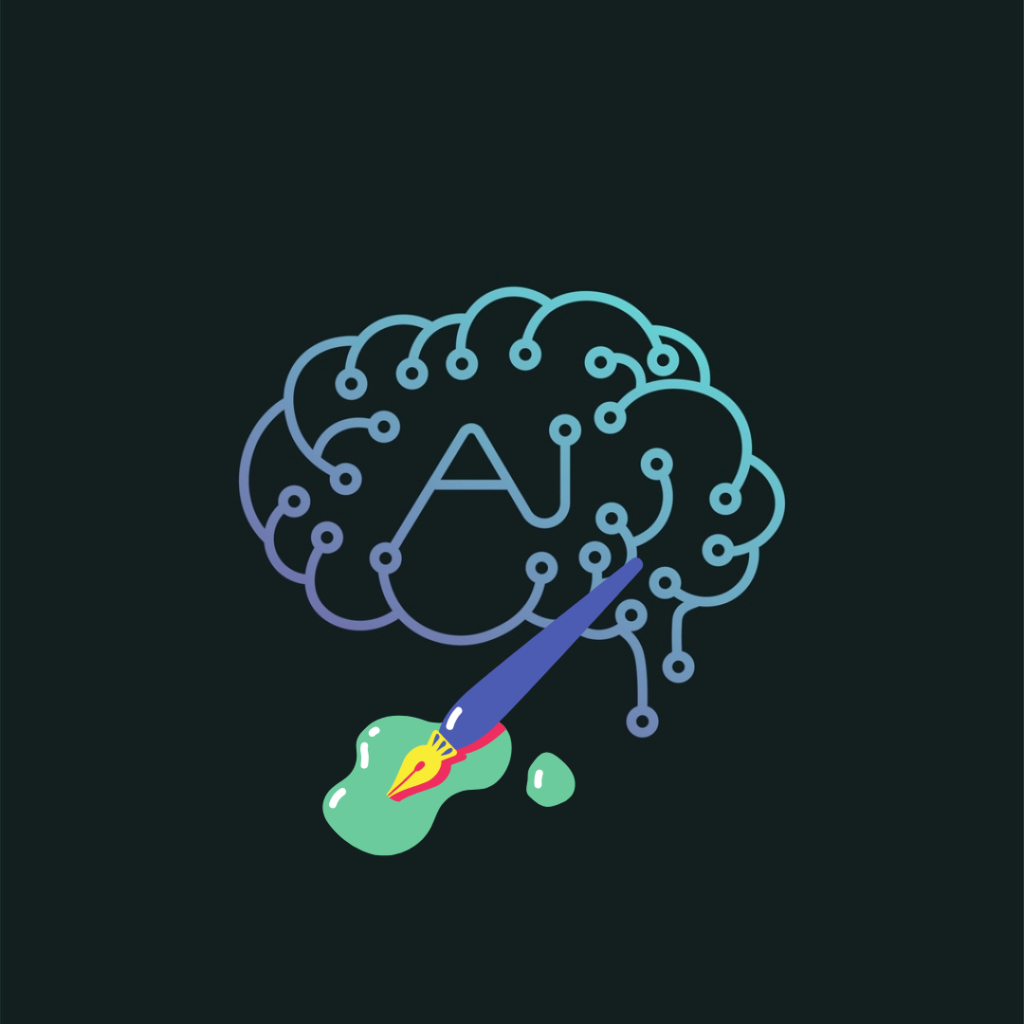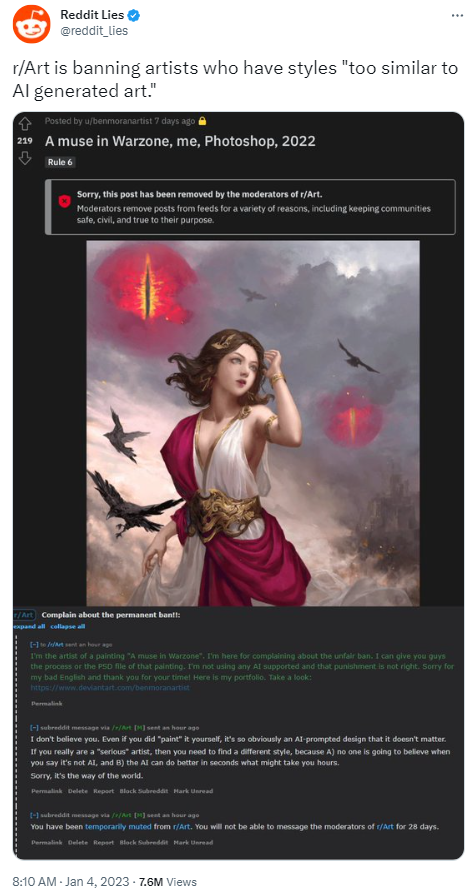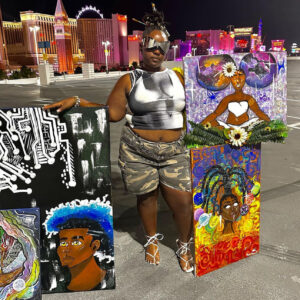
AI Art

Art has evolved over time, from the first paintings on cave walls, pencil on paper, and brush on canvas to digital art via a tablet. Today, no artistic medium receives as much criticism as AI art or art generated by artificial intelligence.
Artificial intelligence has gradually integrated into society and daily life, and as technology advanced, it was only a matter of time before things got out of hand. AI-generated art is an example of this issue as you see artists internationally questioning the ethics of this form of art. Artificial intelligence has been implemented in art in rudimentary ways for a while, such as some artists using models to draw from references. Today, AI-generated art poses a threat to artists as it may use other artists’ work without permission, credit, or compensation to generate the art the user desires.
Multiple AI-generated apps like Lensa report using open-source Stable Diffusion, allowing users to type in keywords to feed to an AI system that will generate an image that fits the description. The thought of it doesn’t seem bad, especially when businesses like Lensa advertise that their app will make art more accessible to those who lack the same talents as artists. This notion ultimately undermines the concept that art is for anyone; anyone can create it.
However, artists aren’t worried about the accessibility of art but how companies may use AI-generated art to undermine talented artists. AI is infamously cheaper than commissioning an artist. Lensa, the popular AI portrait app, has a $7.99 service fee and gives users access to 50 avatars. For many people, this cuts out the need to commission artists. For those artists, a source of income seems to be disappearing in front of them as AI art generator usage gains popularity.
The Impacts of AI on the Art Community
Stolen Intellectual Property

In addition, an article by NBC News mentions how apps like Lensa operate. The article claims numerous datasets, including millions of photos, are used to train image synthesis models, such as Google Imagen, DALL-E, and Stable Diffusion. The models develop relationships between the pixel placement in an image and the image’s metadata, which often consists of text descriptions of the image’s subject and aesthetic. Applications that use any image synthesis systems are complicit in stealing multiple artists’ art styles to produce perfect images for their users. The image synthesis models insert artists’ art into their systems to train their AI to make art based on the keywords the user inputs.
Multiple artists have voiced how they have found similarities between the AI-generated art they’ve seen produced online and their art. Even more damning is when the generated image shows traces of an artist’s logo or signature. As it happens, Getty Images is now suing Stable Diffusion, claiming that their software is “scraping the web to train its art algorithms” and stealing images. This claim results from people noticing AI images that were generated with the signature “Getty Images” watermark that appears on the company’s images, which people are supposed to pay to license the use.
While Getty Images is no small, independent artist, their lawsuit highlights one of the most significant issues the art community has been bringing up – that AI art generators are stealing intellectual property.
The Difficulty of Differentiating Between AI Images and Original Works

Worse yet, artists are now facing a new issue: because the images are based on actual artwork and show similarities to the real art styles, platforms and groups that are now banning AI images are incorrectly banning images thought to be AI-generated that are actually originals made by actual artists.
An Artist Gets Banned
In early January, the Twitter account @Reddit_Lies tweeted, “r/Art is banning artists with styles “too similar to AI-generated art.” The post references a screenshot of a post from the r/Art Reddit group. The post is titled ‘A muse in Warzone, me, Photoshop, 2022’ and published by Vietnamese artist Ben Moran, under the username u/benmoranartist.
In their post, they wrote, “I’m the artist of a painting “A muse in Warzone.” I’m here for complaining about the unfair ban. I can give you guys the process or the PSD file of that painting. I’m not using any AI-supported, and that punishment is not right. Sorry for my bad English and thank you for your time! Here is my profile. Take a look: https://www.deviantart.com/benmoranartist.”
The Response to the Post
Underneath the artist’s post, someone wrote, “I don’t believe you. Even if you did *paint* it yourself, it’s so obviously an AI-prompted design that it doesn’t matter. If you really are a “serious” artist, then you need to find a different style, because A) no one is going to believe when you say it’s not AI and B) the AI can do better in seconds what might take you hours. Sorry, it’s the way of the world.”
To add insult to injury, it appears that a moderator muted the artist. For at least a short while, the r/Art Reddit group temporarily switched to private. It appears to be public again.
Ben Moran’s Calls for Support
On the original artist’s DeviantArt profile is a pinned post where they wrote, “AI art – the revolution of art or the killer who slay all of the Art community? With no excuse, I’m being banned in a 22M follower art group because of my art is look like the food that AI consumed to kill us all – the Digital Artists.
Please spread this to save the future art. We will not want to live in the world that the painting is created by the keyboard, not the brush, paper, and pen.”
This situation highlights more than just the issue of differentiating between original and generated art; it shows how people are responding to the issue itself. The idea of an artist being told they need to change their entire art style to look less fake is truly mind-boggling.
Access is Cheap
A big problem with AI systems is that they are cheaply available to everyone. This has led to instances where fans of artists nonchalantly input their favorite artists’ work into these systems to produce art that emulates their style and techniques.
Infamously, this happened with South Korean illustrator Kim Jung Gi. After his passing on October 3, a French game developer fed Gi’s artwork to an AI to create dupes of his work to pay homage. Not only did this video game developer use Gi’s work without permission, but he also asked users to credit him if they used it.
Additionally, illustrator and graphic novelist Deb JJ Lee shared on TikTok on December 11 that someone on Reddit made their illustrations into an AI art model. As they compared the art to their own, they noticed stark similarities and saw people in the Reddit thread calling out the poster for using Lee’s art, which resulted in them deleting the post. Although that person deleted it, the art model did reach over 70 downloads and is still roaming the internet.
(Article continues after the ad)
Please follow our fantastic site sponsors! They make content like this possible!
Artists Find Out Their Art Has Been Stolen for AI
Independent artist Kelly Mckernan took to Instagram on December 9 to inform their audience they had found out that art they’ve made dating back to 2010 has been used by AI models through haveibeentrained.com. On this site, the user can search if one of their images has been used to train AI. “To me, much of this is unethical; it feels violating,” Mckernan said. “I’m incredibly anxious for the future of my career, more than ever before. Further, I’m concerned for the future of human creativity.”
They stated these thoughts in their Instagram post and advised people not to use AI. The artist also expressed that art students are growing discouraged from continuing their work, and emerging artists feel hopeless. They ended their post by saying, “If artists can’t defend the use of their names and artwork, what have we got left?”
Looking at the way AI art is made, many do not think it’s ethically or morally right. Especially when some people are using AI generators to produce content that they’re then turning around and selling for a profit.
The Morality of AI Art
AI art is similar to fast fashion because it typically offers a nice product at a low price. Like fast fashion companies, AI-produced art profits from smaller creators’ hard work without crediting them. Ultimately, this diminishes the value of artists because they are unwillingly creating art they never wanted or intended to make with no compensation. Non-artists may find this helpful since people either don’t find artist commission prices affordable or feel they do not have the skill to produce the art themselves. Regardless, AI-generated art is theft in the grand scheme of things.
AI-Generated Art Being Sold
Many artists question whether these AI-produced works of art can even be considered art because no human emotion or thinking went into creating them. Paris-based artists Hugo Caselles-Dupre, Pierre Fautrel, and Gauthier Vernier imported numerous portraits into an AI, “teaching” it the aesthetic and style of portraits done in the past. Landing them with a blurred face AI portrait titled “Portrait of Edmond Belamy” that sold at an auction for $432,500. It is interesting that they could produce a 400-thousand-dollar portrait so easily. Many artists like Van Gogh took years to produce paintings that are now renowned and praised.
AI Art Winning Competitions Against Real Artists
Similarly, the Colorado State Fair held its fine arts competition and announced the winners in August. Criticism met the judge’s choice when they awarded synthetic media artist Jason Allen as the winner in the digital category. On Twitter, other artists didn’t see Allen’s entry of art using AI as fair to other contestants. Although Allen entered the digital category, the artwork was created using a program called Midjourney, which is comparable to OpenAI’s DALL-E and the free software Stable Diffusion. These programs utilize the work of many different artists to aid users in creating their artwork. Therefore, Allen’s win isn’t solely based on his talent and is unfair to others in the digital category who worked hard to produce an original piece.
This situation worsened as more people used AI-generated art, and companies wished to implement it in their software. Japanese Illustration app Clip Studio Paint planned to roll out a new AI image generator tool based on open-source Stable Diffusion’s AI Model in its December update but ultimately canceled it due to the backlash. An article on The Verge states that companies like Canva, Shutterstock, and Microsoft are integrating products with similar AI capabilities, but this instance demonstrates a company backing down due to consumer criticism.
AI Isn’t Just Impacting Artists
Since the original drafting of this article, the news surrounding AI has been immense. And, it hasn’t just been surrounding AI-generated art; it now includes AI-generated written content and its effects on the writing world. In addition to the recent lawsuit by Getty Images against Stable Diffusion, on January 26, 2023, The Verge reported that BuzzFeed “says it’s going to use AI tools provided by ChatGPT creator OpenAI to “enhance” and “personalize” its content.” After announcing their intention to use AI to help create content, their stock jumped 150% the same day.
This follows the company’s December layoff of 12% of its workforce, citing “worsening macroeconomic conditions and change in how people consume media.” This led people to call out the move as replacing or consolidating actual people with AI technology, which BuzzFeed denied.
Moreover, people have even begun using AI to write books. As reported by Business Insider, one man used AI to write and illustrate a children’s book in a single weekend using ChatGPT and Midjourney. Within 72 hours, he had already self-published the book digitally on Amazon’s bookstore. He quickly received lots of backlash and negative reviews both on Amazon, and on the Twitter thread, he posted about the initial experience. This sparked yet another debate around the ethics of AI-generated content.
As we move forward on this path toward AI implementation, the discussions around its ethics, the morality of its use, and the consequences of its use will continue to evolve. Time will only tell if AI is allowed to replace artists, writers, and other professions or if society will choose to implement safeguards to minimize the negative impacts on human life.
Get in Motion and Stand With Artists Against AI Art
Ignorance is the biggest thing that fuels these issues and lets them grow. That’s why you can do better when you’re aware of the issue. In NBC’s article Jon Lam, a storyboard artist for Riot Games, said, “ Anytime people use it more, this thing just keeps learning.” The main way to help artists through this AI invasion is to avoid using AI-generated tools and applications, especially if they explicitly mention open-source Stable Diffusion or anything similar.
To help artists, there are a few things you can do. For one, refrain from using AI generators. There is no way to guarantee the image or content you’re generating isn’t stolen from other artists, so it’s best to avoid its use altogether.
Tell Artists When Their Art’s Been Stolen
Next, many artists use social media as a stepping stone, so they must establish public accounts to connect with potential customers and opportunities. Supporting both professional and student artists is another approach. Keeping an eye out for their art possibly being used for AI-generated art and letting the artist know it is also helpful.
Buy Art From Real Artists
To further support those artists, see if they sell prints of their artwork, which tend to be more affordable than an original piece. This helps by paying the artist for their work while also getting a piece of authentic artwork. While commission work can be expensive, at the end of the day, it’s someone’s time and energy put into it. And that deserves all the credit and compensation that comes with it.
Taking the easy route by using AI software to produce a cheap, stolen piece of work is wrong, plain and simple. Especially when people are creating AI images to turn around and sell as their own, ultimately profiting from the work of others.
Create Art For Yourself From the Heart
Lastly, those who use or are tempted to use AI generators to create art because they’re “not good” at creating it themselves should reflect on why they feel that way. It’s important to understand that the commodification of art has created the idea that if you can’t sell your art, it’s not worth the time to make it or that it’s not “good.” That’s just not true.
Art is subjective, and it’s expressive, it’s meant to be an extension of oneself and their feelings or interpretations about the world. It’s an inherently human experience to create it, and there are infinite ways to create it. You are not limited to your drawing or painting abilities, and the art you create should come from the heart – not generated by a machine that just spits out an amalgamation of other people’s art. Throw away the idea that you have to be skilled at art to create or enjoy it.
Thank you to our supporters and sponsors!
As always, we want to thank our Patreon’ Cultivator’ supporters and sponsors who help make content like this possible.
The following Patron(s) supported the production of this article:
Crystal Gropp
The following sponsors supported the production of this article:
Viva La Compost & LunaKai Lash



